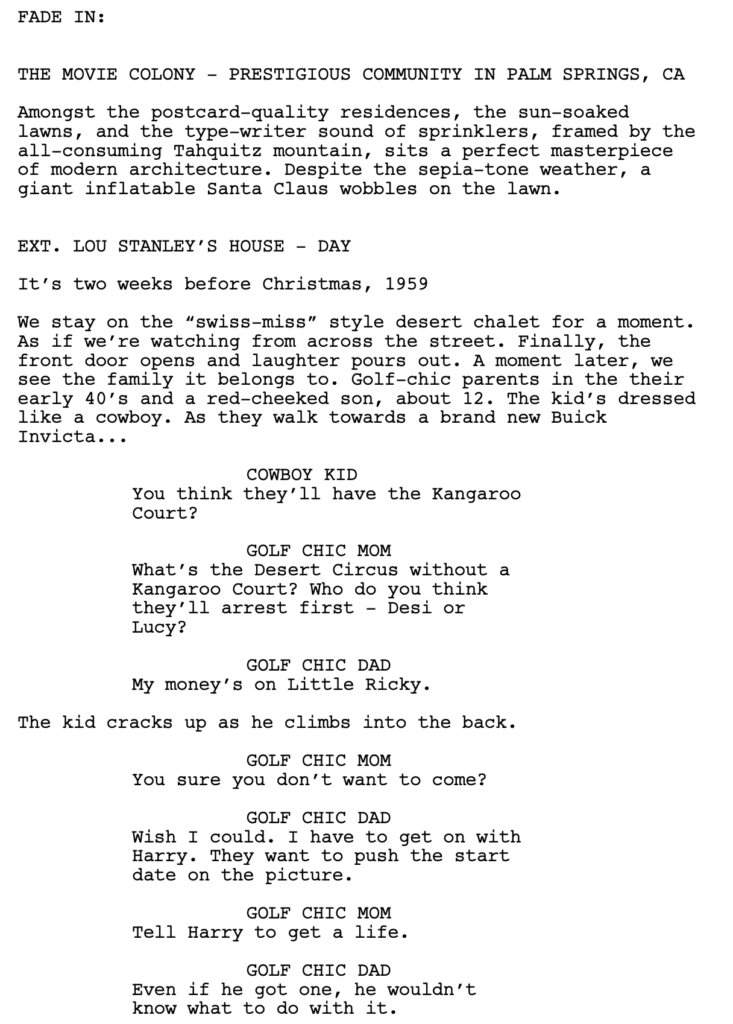
Tomorrow, I’ll be reviewing the winner of Scene Showdown! But today, I want to look at one of the scenes that didn’t make the Top 5. Obviously, there were a ton of scenes that didn’t make the cut and I wish I could break down all of them. I chose this specific scene because it’s a good representation of the level of writing I received in the Showdown.
I’m hoping, with this breakdown, I can help both the writer and all aspiring screenwriters who are trying to get better at scene-writing. Let’s get into it!
Title: Reaper
Genre: Horror
Logline: When a high school girl discovers her family’s shocking connection to the Grim Reaper, she must save her little brother before a violent curse overtakes him. Some family secrets should stay dead.

From the very opening paragraph, I’m worried. “PUSH INTO the back of DAD’S head.” This is sort of a weird description and I’m not sure what to do with it. I generally understand that we’re behind a character and the camera is pushing into the back of their head. But my question is, “Why?” Why start pushing into the back of someone’s head? So we can see the details of their new haircut?
I don’t really know what “hardline posture” is. That leaves me with two questions in the opening paragraph and that’s usually enough to bail on a script. If I’m struggling to make it through the opening paragraph, based on my previous reading experience, I know there are going to be a lot more questions in the pages ahead.
I’m guessing that this image is meant to convey that a really bad storm is coming and they need to get to safety. The reason I believe this is because the writer has started with that image – the image of a man staring out into a storm. Whatever images you start with, the reader assumes those images are important. So I wouldn’t expect this to be a casual storm. I’m expecting it to be a big storm.
This is followed by voices in the background discussing something. This is a pet peeve of mine – when you start a script with voices from characters we haven’t met yet. Early on in a script (or, in this case, a scene), the reader is desperate to understand what’s going on. People speaking who don’t have names yet creates an air of confusion and frustration.
Case in point, as I mentioned, I assumed they were leaving because of the storm. But when I read the scene back, I’m thinking they’re leaving because something is happening in the house. The reason I didn’t pick up on that the first time was because I was expending my mental energy on figuring out who these voices were. That prevented me from focusing on the content of what they were saying.

I’m getting frustrated now that people who are important enough to dictate what happens don’t have a name yet (The Woman). I would like to know, one page in, if this is a mom, if this is an Aunt, if this is a friend. And what is their name? Us readers are desperate to make sense of things so the more you leave basic things unknown, the more frustrated we get.

“The Woman dips into frame, her worried brow creased like bedsheets after a fitful rest.” I don’t dislike this line but it reads more like a line from a novel than a screenplay. Screenplays need to get to the point. They’re not about nailing the perfect analogy or metaphor. This writing choice is not something that would make me stop reading but it’s something that, when combined with the problems I’ve already mentioned, might be the final nail in the coffin.

I’m realizing, at this point, that I don’t know why this family is leaving. As I pointed out, I initially thought it was because of the storm. But then I thought maybe it was because of something that was happening in the house (a haunting, perhaps?).
The reason this matters is because I need to understand what the engine underneath the characters’ actions is in order to enjoy the scene. For example, if you had established that something was after them in the house, now I know that the car ride is to get away from that something. But since I don’t know why they left the house, there’s no tension or purpose within the car scene. They might as well be on a road trip.
It makes lines like this: “Dad drives, locked forward, white knuckles groaning against the rubber steering wheel,” confusing because why have white knuckles when there’s been no clearly established threat? Yes, there have been allusions to a threat. But if the nature of the threat hasn’t been established, the reader is not going to feel any tension or anticipation or suspense or worry, which are all the things the reader *should* be feeling in a scene like this.
It affects even the end of this segment, where Cass makes the duck joke. A joke that is made specifically to cut the tension makes sense. But if we don’t feel the tension, the joke is just a random joke.

At this point I don’t know what I’m supposed to feel. The second a character farts in a script, I consider that script slapstick. Fart humor is lowest common denominator humor so my feelings about this scene are plunging quickly. Just a page ago, we seemed like we were in a really serious place. Now it’s all shits and giggles, literally.
I suppose you can argue that Max and Mark are trying to lighten the mood. But, as I’ve already established, I don’t know what the mood is. I still don’t know why they’re driving somewhere or if they’re trying to escape something. By the way, the first time I read this scene, I thought Max was the dad. Only when I went through it again did I realize he was the kid. That’s what happens when you start your script with voice overs from characters we haven’t met yet. It makes every character that much harder to identify.

I’m not sure what “suckles from the blade” means. One thing that is definitely a big problem in screenwriting is when basic actions cause confusion due to the way they’re written. Constructing clear and concise sentences should be the easiest part of screenwriting. So if that mistake is happening, it needs to be fixed immediately.
The best way to fix this problem is, usually, to simplify it. We often try and be too clever by half with our writing when a simple description will suffice. I believe the writer is saying that Mark is sucking the blade. But I don’t know why. So tell us he’s sucking the blade and tell us why.
Here’s a tip for screenwriters. When you write the description in your script, write it in the clearest form possible. Don’t get cute. If the character is walking to a table, don’t say, “He sashays unwittingly to the table, like a raccoon on Broadway.” Just say, “Joe walks (or hurries) to the table.” Then, in subsequent drafts, if you want, you can add some flavor to the description. The problems with sentence structure often begin when the writer starts off with some unwieldy description. Start simple and if you feel like, later on, the description needs more flavor, add it.

I see and respect what the writer is trying to do here. Drifting onto the median implies that something bad is about to happen which, in turn, builds suspense. So the scene is picking up.
But this is the funny thing about screenwriting. You can do something good on page 40. But if everything leading up to page 40 was average or slightly-above-average, the reader is not going to be invested in what’s happening. They’re only going to be invested if you built up a compelling story in those previous 40 pages.
Same thing here. I like that things are picking up. But I still don’t know why they left the house. I don’t like the weird vibe in the car where people are farting and pretending to be apple-mouthed Draculas. I’m more confused than I am entertained and, therefore, when genuine suspense-initiators are introduced, I’m only partially invested.

When a character tells a story in a script, it is, in essence, no different from the overall story being told in your screenplay – IT MUST BE ENTERTAINING. This story about how the dad needed to get a job is fine, I suppose. But is it worthy of taking up the bulk of the dialogue in the car? I would say no. I’m not even sure why the story is being told. Is it Christmas time? is that why he’s relaying an old Christmas story? I’m struggling to see how the story connects to the situation.

This is the best part of the scene, hands down. We have the payoff of drifting into the middle lane. We have the payoff of Mark mucking around with a knife. The image is shocking, borderline disturbing. So, to that end, I give the writer credit. Something definitely HAPPENED in this scene, which is more than I can say for the majority of the scenes that were entered into Scene Showdown.
I don’t get the part where “something’s wrong with Dad,” though. Maybe that will be explained later in the script. I do think, for the sake of only being able to submit a single scene, the writer should have better set up that “something” that was “wrong with dad” earlier in the scene. That would’ve given the dad’s decision to crash the car more punch.

The final image is a fun one. I like the apple stabbed into the throat. The looming grim reaper looking down on him is also a good shot. So the scene ends with a kick, which is nice.
But let’s go over the reasons why the scene didn’t make the Showdown. One, the opening had too many unclear moments. Two, there were some clunky descriptions. Three, I didn’t know why they left the house. And finally, four, the scene didn’t achieve the main thing it was trying to do, which was create a tension-filled car ride.
Hopefully, this helps the writer out. Now it’s time for you guys to chime in. What did you make of the scene? Share your thoughts in the comments. :)
I’m swamped trying to put the October newsletter together so today I’m re-posting my script review for Megalopolis. Enjoy!
Genre: Drama/Event/touch of sci-fi
Premise: An architect in a futuristic New York City tries to create utopia with a new mini-city.
About: One of the more famous scripts in Hollywoodland, this is Francis Ford Coppola’s long-gestating “dream project” which you’ve likely heard about in his interviews. Coppola, who notoriously lashes out at the studio system whenever he gets the chance, says he only made his last three studio films, Bram Stoker’s Dracula, Jack
, and The Rainmaker
, so he could make Megalopolis. He started looking at actors and scouting locations for the film, but then September 11th showed up and changed the landscape of New York. Said Copolla: “It made it really pretty tough… a movie about the aspiration of utopia with New York as a main character and then all of a sudden you couldn’t write about New York without just dealing with what happened and the implications of what happened. The world was attacked and I didn’t know how to try to do with that. I tried.”
Writer: Francis Ford Coppola
Details: 212 pages!!!
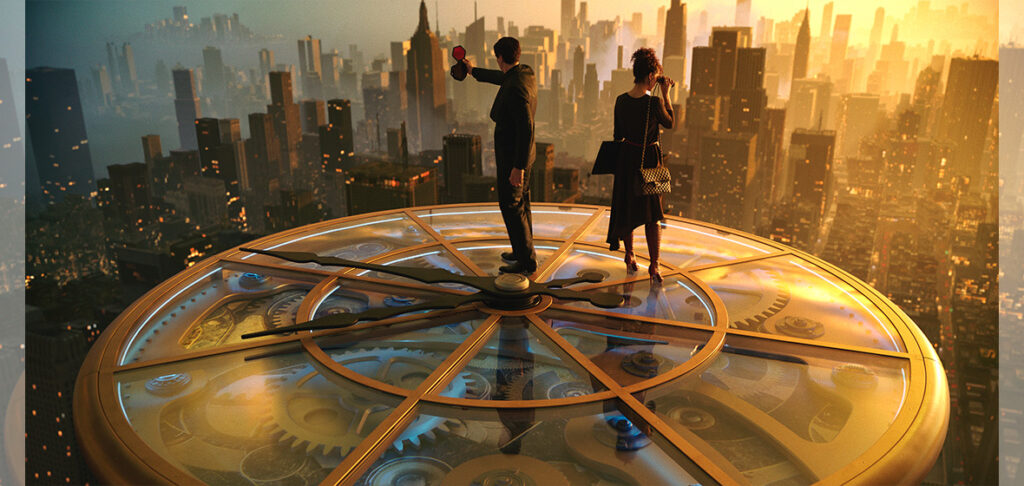
For all you youngsters out there, Sofia Coppola was not the first of the Coppolas to make films. There was a time when a guy named Francis Ford Coppola, her father, used to make movies too, and pretty good ones at that (you may have heard of The Godfather
and Apocalypse Now
). But Francis came about in an age where experimentation was celebrated above commerce, and studios weren’t owned by corporate giants who only cared about the bottom line. So when the business grew through the 80s and 90s, it kind of left Coppola behind and killed the ability to make films like Megalopolis. As he points out, “You see the movies they make now. They just keep making the same one over and over again.”
However, blaming others is always the easy way out when things don’t go your way. It’s not “my” fault this isn’t a movie. It’s “their” fault. Whoever “they” may be. Maybe it’s the studios. Maybe it’s the suits. Maybe it’s the ticket-buying public themselves. “They” don’t understand what good movies are, which is why they’re not asking for movies like this one.
I happen to think that now is the most prominent time for experimentation in film EVER. Sure, you can’t do that experimenting on a 70-150 million dollar platform, but should you really be that pompous as to require 100 million dollars for an idea that has the potential to top out at 20 million? The more I think about it, the more absurd those old movie practices seemed to be. You might as well have gone to Vegas and put it all on Red.
Anyway, I’ve heard about Megalopolis so many times at this point that I finally decided to sit down and read it, despite its ridiculous 212 page length (making Titanic look like a Pixar short). I wanted to come to my own conclusion as to why the film was never made. Is this a great film in waiting that slipped through the cracks or a cinematic disaster of mega proportions?
Serge Catalane is our genius architect anti-hero, a controversial public figure whom the public has a love-hate relationship with. These days Serge does two things – work and gorge himself in debauchery. Serge would impregnate a mule if it gave him even a split-second of euphoria. Of course all his excess is to muzzle the sad man that he really is, which is probably why he works so hard – to keep reality from rearing its ugly head.
There are a TON of characters in Megalopolis. Too many for this reader to keep track of. I always tell writers to cut down their character count so that the reader isn’t backtracking every five pages to figure out who’s who – a surefire way to sap the entertainment out of your script. If you want to see just HOW damaging this practice can be, download Megalopolis and read it now. It’s like being in charge of immigration in 1853 New York without a book to write in. You just have to memorize the 18 trillion names in your head.
The key players are Mayor Frank Cicero, who wants to build a new modern mini-city inside of New York called “Cityworld.” He’s partnered up with the richest man in the city, 70 year old Gene Hamilton, to deliver this utopia. Then there’s Julia Cicero, Frank’s wild child daughter who doesn’t agree with his conservative ways.
Frank and Gene seem to have everything in place to make Cityworld happen when Serge charges in and says he has a cheaper cooler mini-city to make called “Megalopolis.” All the investors care about is the bottom line, so they kick Cityworld to the curb and give Megalopolis the go ahead.
Frank becomes obsessed with taking Serge down but that plan goes screwy when his daughter (the aforementioned Julia) falls in love with Serge and joins him in his quest to create Megalopolis.
That’s when the weird starts happening. There’s a Cher/Madonna/Angelina Jolie like diva named Wow (yes, that’s her name) who I believe is marrying 70 year old Gene but who is secretly having an affair with both Serge and another guy (one of the bankers maybe?). She keeps popping up, though I couldn’t tell you why as I’m not sure she had any influence on the plot at all.
Then there’s Vesta, a 15 year old pop star who oozes sex and I believe is supposed to be a commentary on Britney Spears, although I thought this was written before Spears blessed America with her talents. Serge ends up banging Vesta in a sex tape and Frank and Gene help get that tape exposed, in the hopes that it will derail Serge’s Megalopolis.
It doesn’t. In fact, not only does the court not give a crap, but Julie (conveniently) could care less as well. She lets Serge sleep with whatever and whoever he wants, explaining that it’s a small price to pay in order to be associated with genius. Aww, true love!
We then watch this thing get built over the next five or so years as a myriad of obstacles (some of them soap-opera’ish, others political) try and derail Megalopolis. It all culminates in a huge bloody violent finale festival celebrating the opening of the city dubbed: “Saturnalia.”
Megalopolis is one of those ideas you get early on as a writer that you like because of its ambitiousness, but never really consider how unfit it is as a full-fledged movie. It has bits and pieces of coolness but there’s no one thing to latch onto.
Minutes after finishing the 212 page opus, I still don’t see what the attraction of the film would be. It’s set in the future, which technically makes it sci-fi, but there’s not anything sci-fi about it, which brings it back into the realm of a “normal movie.” Which means you have a normal movie about a guy building a mini-city inside a city, which is kind of confusing when you break it down…….I mean am I the only one struggling to figure out what the hook is here?
What Coppola may have been going for was the next Citizen Kane, exploring a deep, complicated, flawed character’s obsession with his legacy, and more specifically what happens when an out-of-control ego and all the money in the world combine. But trying to write the next Citizen Kane is like trying to build the next Eifel Tower. It’s such a specific thing, nobody can replicate it.
My biggest problem, from a story sense, was that I didn’t like Serge. Anti-heroes can work but as I’ve pointed out numerous times, you have to give us something in a character to root for. It should preferably be substantial but at the very least minor.
I didn’t like anything about Serge. He was cold, he was rude, he was selfish, he was a misogynist, he was a cheater, he was a rapist. Lol. I mean come on here Francis! Throw me a bone! The goal here – to finish building Megalopolis – is a strong one. But it’s worthless unless we care about the man who’s trying to achieve it.
And don’t even get me started on the number of characters. At a certain point, when you’re writing a screenplay, you have to sit back and ask yourself, “Do I really need ONE MORE CHARACTER here?” Isn’t 30 enough? Do I need one more subplot that’s going to add one more 25 minute chunk to a movie that’s already 3-plus hours long?
I’m thinking specifically of Gene’s hotshot miracle-boy son, Claude, who has this whole subplot about trying to take Serge down. Why not just make Gene and Claude the same person? They’re both trying to do the same thing. Stuff like this is going to annoy anybody who’s put aside 4 hours to read your screenplay.
I hate to make this comparison but Megalopolis is kind of like a more sophisticated version of Southland Tales. Super-ambitious, but painted in all the wrong colors. We don’t get Justin Timberlake dancing in videos or cars banging each other, but Vesta and the whole statutory rape storyline felt like another universe altogether, creating a surreal touch that never quite gelled with the more conservative main plot.
You have to give credit to Coppola for creating something this complex and ambitious. Unfortunately, the pieces never end up fitting together, and the idea itself is too obscure to ever work as a whole. Luckily, this one is online for you guys to check out yourselves. So if you have some extra time, read it and tell me what you think.
Script link: Megalopolis
[ ] What the hell did I just read?
[x] wasn’t for me
[ ] worth the read
[ ] impressive
[ ] genius
What I learned: Sometimes you have ideas that JUST. DON’T. WORK. I believe one of the greatest talents a writer can have is recognizing when an idea isn’t working and abandoning that script. Because if you spend six more months, or twelve more months, or, gasp, 2 more years, on that script that isn’t working, that’s 2 years you could’ve used to write something that did work. I believe Coppola held onto this so long because no one gave it to him straight. No one told him, “This will never work.” (and why would they? He made the freaking Godfather!) As writers, it’s our job to read between the lines when someone gives us feedback. If you give your script to ten people and their enthusiasm level is a collective “meh,” no matter how polite that “meh” is, your talents may be better suited working on another idea.
Genre: Slasher
Premise: In the cutthroat world of K-POP, a group’s debut is threatened when someone begins to violently attack its members.
About: This script finished on last year’s Black List. The writer, Lynn Q. Yu, came up with the idea during the pandemic when she went down the K-pop rabbit hole after watching Netflix’s documentary about Blackpink (Light Up the Sky). “That was my first time sort of learning about the trainee camp system, and how insanely competitive it is.” The script almost sold before the strike. “Going into late April, we actually had four parties that were very interested in it. At the end of April, we got a studio to offer money. But ultimately, they low-balled us. We had to walk away from the deal because it was right before the strike. I remember negotiating on April 28 and the strike started on May 1. They were basically trying to buy me out for a very low price, hoping I would accept the floor right before the strike.” You can read more about the writer and Unnie over at Joysauce.
Writer: Lynn Q. Yu
Details: 106 pages

Sometimes I wonder why every script isn’t about K-Pop.
Don’t you?
Okay not really but…
One of the big challenges in screenwriting is the decision you have to make at the concept stage. You can write something more personal that resonates with you and, therefore, will be more enjoyable to write. Or you can write something that is more saleable, a juicier more marketable concept. Unfortunately, those are harder to write since you don’t care about them as much.
There are a few blessed screenwriters out there whose passions align with what’s marketable. So, for them, it’s easier. There is another option, though. Try to find the heart in the marketable idea – something you resonate with – and use that to guide your script. That way, you’re incorporating the best of both worlds. That’s what happened with Lynn Q. Yu here.
“I had hit a moment in my career, where I felt I had hit a wall. I was questioning whether I was good enough, whether I was talented enough. I wanted to write a story where a protagonist was really struggling with their own talent and adequacy. What if the reason they failed wasn’t because of the system? But because someone younger and hotter and more talented came up and supplanted them, which is something that I think most creatives have to deal with and have to go through. I combined those themes, but set them in this K-pop world.”
26 year-old Hoyeon Cho is known in her group as “Unnie,” which means “older sister” in Korean. In this case, it might as well be a racial slur. Nobody wants to be called older anything in the youth obsessed world of K-Pop. Unnie is part of a 7 person group of K-Pop members who are trying out to make the final group, which will consist of only 4 of them.
The other members are 22 year old butch Jae, wisp thin 20 year old, Raya, religious 20 year old, Nari, loud 21 year old Hana, spoiled rich 18 year old Min-Ji, and 20 year old adventurous Chaeyoung.
When Chaeyoung is attacked in Koreatown (in LA) and beaten into a coma by a young woman dressed in a pixie K-Pop costume, a new girl, 19 year old Sara, comes in. Sara is super-odd and spends a lot of her time staring at people while saying nothing. Creeeeepy.
Unnie is suspicious of Sara right away and begins watching her every move. With only 2 weeks left before the final four are chosen, she’s not leaving anything to chance. On the second night Sara is there, Raya is beaten to death in the tool shed outside the house they’re all staying at.
Next thing you know, Sara is seducing Jae, who’s more than happy that this hot young whippersnapper is into her. It appears that Sara is manipulating everything, pulling the strings to ensure that she makes the group. Meanwhile, Unnie battles with their overbearing manager, Grace, who also happens to be her older sister.
Just when Unnie thinks she has the smoking gun to take Sara down, she realizes that the real disruptor may be closer to home.
There comes this moment in every script I read where I know that this is going to be a script of value or a script I’ll forget as soon as I finish. It typically comes within the first 40 pages. Usually earlier but it has happened later.
It amounts to a featured scene where something of significance happens. In this script, it happened around page 40 when the group was practicing their dance moves. Sara is new to the group and has, so far, been told to watch and pick up what she can.
But the manager decides to throw her into the mix. “Get in there and do your best.” In that moment, I thought to myself, “If Sara goes in there and is perfect and better than everyone else, this is going to be the type of script I forget as soon as it’s over. But if, instead, something unexpected happens, I’m probably going to like this script.”
So, what happened?
Sara went in and was perfect. I knew then the script wasn’t going to clear my, admittedly, high bar.
To be clear, I’m not saying the script is bad. I actually thought the script was fine. But there are SO MANY FINE SCRIPTS IN HOLLYWOOD. There are maybe 500 fine scripts. 1000 possibly. Maybe as many as 5000. In order to write a script that resonates with people, you must aim for above fine. WAY above fine.
And even though there’s no singular way to achieve this, one of the things you definitely want to do is place yourself in the reader’s mind while you’re writing and check in with that mind to see what they’re expecting. Once you know what they’re expecting, you can play with that. You can sometimes give them exactly what they’re expecting. But, at key moments, you should probably use what they’re expecting against them.
I knew as soon as Sara went in there and was perfect how this script was going to play out. It was a leverage moment in the script where the writer, whether they knew it or not, was telegraphing to the reader what kind of creative choices they were going to make. In this case, safe expected choices.
If Sara had screwed up or was lost or buckled under the pressure or was laughably bad, I would’ve had no idea where this script was going. And that’s where I want to be.
I remember reading the screenplay for Black Swan before it came out — another high pressure young dancer movie – and there was this scene where the main character has sex with her rival one night. I didn’t know what was coming next. Those are the kinds of choices that elevate a read.
I *do* think this script is marketable. It feels a bit like Smile 2, which looks good and will probably make a lot of money. But it doesn’t do anything that gets you excited. It plays out like you think it will. There’s a late script reveal where we learn who the killer is and it surprised me. But because the lead up to that reveal was by-the-numbers, it didn’t move the needle. You have to try and move the needle with your script. Even if you don’t succeed, you need to try.
This, like a K-Pop group, felt too safe.
[ ] What the hell did I just read?
[x] wasn’t for me
[ ] worth the read
[ ] impressive
[ ] genius
What I learned: In these ensemble scripts ESPECIALLY, where you have seven girls around the same age in a lot of scenes together, you must spend your script prep differentiating how they speak so that we can pick up who’s talking just by the dialogue alone. If they’re all using the same vocabulary, the same subject matter, the same slang, the same rhythm, the same number of lines every time they speak, we won’t be able to differentiate them. So take that extra time and try and separate each of them through their dialogue alone. That’s REALLY going to improve the read.

I know some of you are going to be upset with me that I’m not reviewing Megalopolis. But look. The one thing I can’t stand is purposeful disregard for screenwriting. When they, the writer, believe they’re so above the fold, that they can disregard all convention and write whatever the heck comes to mind.
Who sets up a character’s ability to stop time and then just… never pays it off? I’ll tell you who. Francis Ford Coppola.
I’ve read the screenplay. Years ago. There was more pretension in that script than a West Hollywood farmer’s market. And it looks like Coppola hasn’t changed anything from that draft. Why does this matter? Because I read 25 scripts like Megalopolis a year. Big operatic pieces of bloat with a million ideas and nothing to guide them. These screenplays are born out of writers who have imprisoned their inner editor. Whatever they think of, it goes in the script. AND IT NEVER COMES OUT.
Which is Megalopolis to a T.
It is not art.
It’s laziness.
Ego-driven writers believe they’re creating the former because they’re following their writing soul. But when you don’t identify the suckiness in your script and taking the time to get rid of it, you’re just lazy.
The craft of screenwriting is built on improvement. It is about taking your ideas and using each new draft to improve them, reorganize them, elevate them! Which is actually fun. I love improving stuff. Finding a more interesting way into a character. Coming up with a better set-piece. Identifying some form of conflict that turns a boring conversation into an exciting one.
Coppola is not interested in that. He’s using the George Lucas Phantom Menace method of screenwriting – one-draft-and-done. And then he wonders why his movie only made 5 million dollars on opening weekend.
It’s because when people see the trailer, THEY DON’T KNOW WHAT THE MOVIE IS ABOUT. If people don’t understand what they’re going to see, they don’t go. Period. It’s one of the things good screenwriters think about when they put a script together: Is this premise clear? Will it be clear in logline form? Will it be clear when I pitch it to someone? Will it be clear as a trailer?
Think about that. If someone asked you to pitch your movie right this second, would it be quick and easy to do so? Or would you talk for five minutes and stumble all over yourself trying to explain it?
Because when I look at Megalopolis, I don’t see an elevator pitch. I see a space-elevator pitch.
Consider this a plea to screenwriters everywhere: Come up with clear concise ideas that have clear concise executions. The more complex the nature of your story, of your narrative, of your plot, of your structure, the more time you’re going to have to put into the script to get it right. More drafts. More feedback. More reshuffling your ideas of what the movie is. It can be done. But you need a legion of people helping out. You’d think Coppola would’ve been smart enough to do that but I get the impression he didn’t call a single fancy friend of his for feedback.
Okay, let’s move onto Wolfs, one of the oddest movies you’ll see all year.

What I like about Wolfs is that it’s the kind of movie Hollywood used to make – a movie star movie. Every frame of this film is dependent on movie star faces being on screen. Because if you took those movie star faces off for even a second, this would fall apart real fast.
It’s still cool to see though. This is the type of movie that would’ve done gangbusters at the box office in 2002. So it does feel a bit odd to watch it on streaming. You feel like these guys deserve more, even if Apple paid every above-the-line talent member 500 million dollars so they could have this exclusively on their channel.
And you know what, for a good 30 minutes there, this was more than just a movie-star movie. It was a fun little contained screenplay about two fixers who get called to the same job. If you haven’t seen the film, Amy Ryan, who’s the district attorney, hires a male prostitute and brings him up to her hotel room where he begins horsing around and accidentally falls onto a glass table and dies.
She calls a fixer, George Clooney. But as soon as he starts cleaning up, Brad Pitt arrives. He’s been called by the hotel manager, who has cameras in the rooms and saw the whole thing. The two then have to clean up this mess, George for Amy Ryan and Brad for the hotel. But due to the intricate nature of everything, they both have to work together. Things then take a turn for the crazy when they find out the prostitute had blocks of heroin on him and, oh yeah, he’s still alive.
I believe, at one point in time, that this entire screenplay took place in the hotel room because that’s the better story. Or, at least, the story that could play out in the more clever way. Once the kid comes back to life and they have to chase him all over the city, any chance at a clever fun screenplay was abandoned especially once you start throwing arbitrary Eastern European criminals into the mix (the Albanians and the Croatians).
Writer-Director Jon Watts makes a choice that, no matter what, George and Brad are going to be cool in EVERY SINGLE FRAME and while sometimes that works, there are other times where it flat-out stifles the scene. The two are SO not bothered when this kid runs across the city that I didn’t feel an ounce of worry that they wouldn’t catch him. That’s the whole point of the scene, to make the audience worried that he might get away. But if the actors (the characters) never worry for a second, why would I worry?
But then there are times where it worked! My favorite moment was when they had to crash a wedding and got pulled into the main wedding dance with all the men, in a circle, dancing wildly. The contrast between the Croatian’s dancing exuberance and George and Brad’s hang-dog looks while being pulled round in a circle was hilarious.
There were some missed opportunities in the script. The story got a little less exciting when we learned that the kid was just some random dude and not a prostitute. Because I would’ve loved to rope a prostitute in there and get Amy Ryan on board for more than the opening. But I know why they did it this way. They didn’t want three good-looking guys running around the city. Watts needed contrast. So he went with a dopey kid. Why would Amy Ryan bring a dopey aggressively unsexy kid to her room? She wouldn’t. Which is a plot hole you have to accept.
I think if this entire movie stayed in the hotel room (or at least the hotel), it would’ve been better. And if George and Brad’s energy raised up as the movie went along, to match the energy of what was happening, it would’ve been better. It’s still not a bad way to spend two hours and it’s a low-key Christmas movie if you need something for the family to watch (okay, maybe little Darla can’t watch). Overall, I say it’s worth checking out.
What I learned: Here’s a tip. I want every screenwriter to pick a night of the week. Any night is fine. Then, practice the pitch of your latest script out loud. Do one quick “logline” version. 10 second pitch. And then do one longer version where you fill in the details. A 1-2 minute pitch. Practice these once every week so that when someone asks you what you’re writing, you won’t stumble all over yourself telling them. Cause if you wait until the first moment someone asks you to pitch your script, I guarantee you it won’t sound any good.
Come one, come all, and vote for your favorite scene!
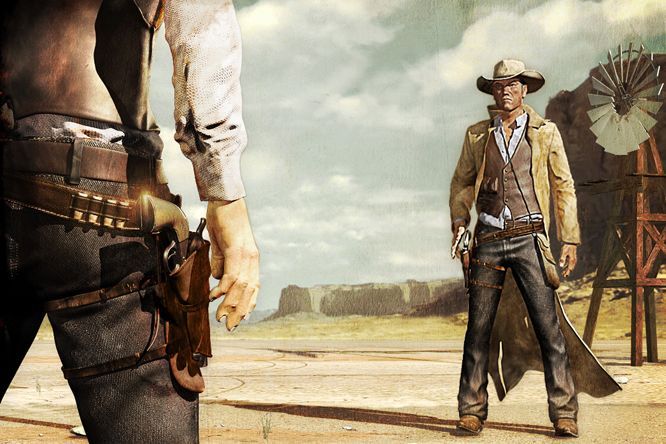
It’s HERRRRRREEEEEEEE!!!
Scene Showdown you wiley little fashionistas!
I had a lot of fun reading through all the entries. It taught me a lot. It’s clear now that some people know what a scene is and some don’t. It’s clear to me that some people understand the importance of entertaining during a scene and some don’t. We’ll talk about that more next week because I definitely think there are lessons to learn here.
A lot of people had solid scenes that didn’t quite make the cut. Brett Martin’s unique take on Jack The Ripper was fun. Finn Morgan’s mid-air attack on Air Force One was exciting. Nick Maiorano’s wife-strangling scene minutes before the family comes over for Christmas dinner almost made the cut. Colin O’Brien’s time-traveling kids scene flirted with the top 5. Ioannis Kementsetsidis wrote a fun scene about a reporter investigating an old lady in possession of a mysterious gemstone. Andréas Edelman wrote an inventive scene about what life is like in a world where the government has cracked down on laughter. And there were a few other good scenes as well!
But these were the top 5 scenes in my opinion. I’m going to post the first page of each. But you can read the entire scene by clicking on the links for each entry. After you’re finished, vote on your favorite scene in the comments section. Voting ends on Sunday, September 29th, at 11:59pm Pacific Time.
Good luck!
Title: The Factory
Genre: Thriller
Logline: A paranoid factory inspector touring the headquarters of a successful razor company on the verge of a sale is offered an exclusive glimpse of their newest – and most shocking – product yet.
Scene Setup: We open our feature on an exhausted father. Taking his daughter home on a nighttime train. What could go wrong?
Full Scene Link: The Factory
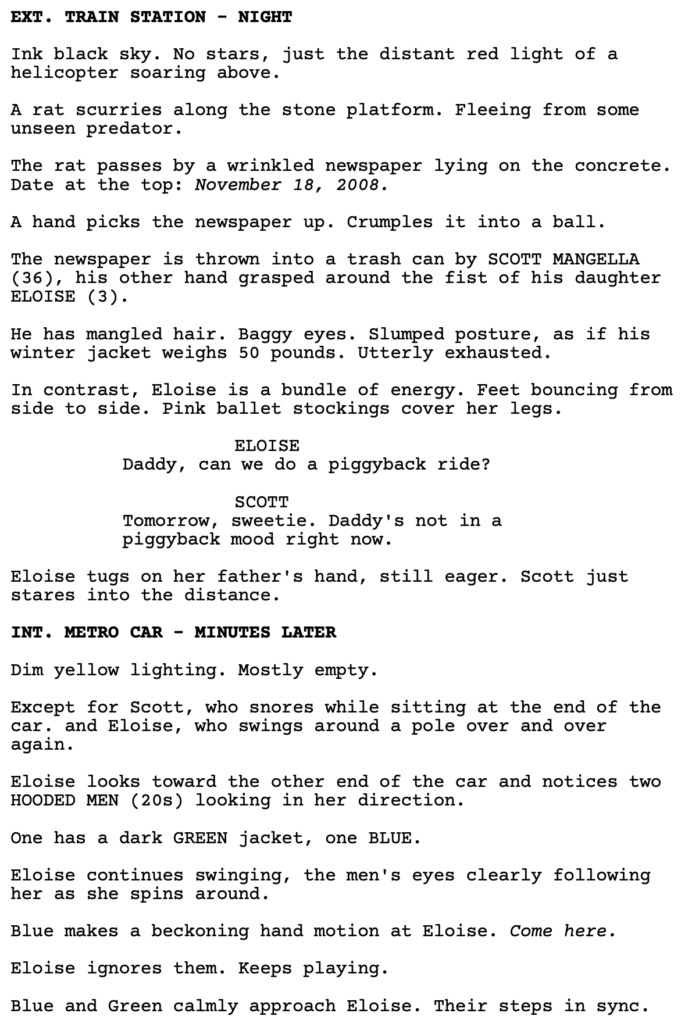
Title: Sign of the Times
Genre: Comedy, Coming-of-Age
Logline: An offbeat high school senior’s directionless life gets a bit more interesting when she grants an elusive first date with a boy who didn’t even ask her out.
Full Scene Link: Sign of the Times
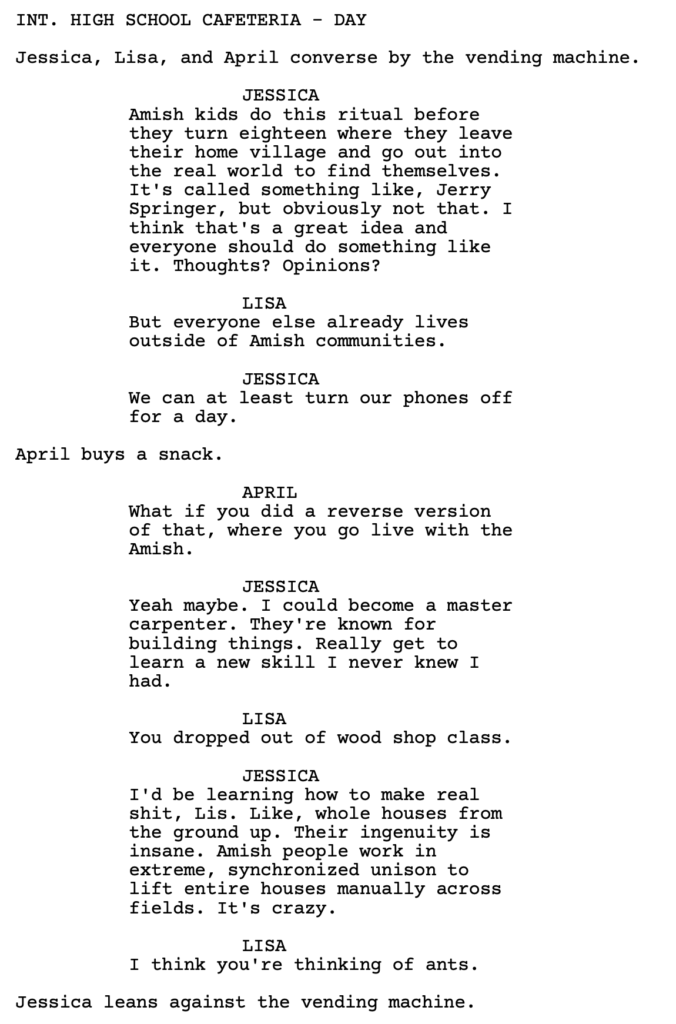
Title: Caught in the Open
Genre: Horror/Thriller
Logline: A cross-country road trip runs straight into some big trouble.
Scene Setup: Fleeing from an abusive relationship, BILLIE-MAY and her nine-year-old daughter, ELLIE, have just set out across country in a beat-up old Corolla. But their escape route takes them through an area that’s recently seen a number of murderous attacks by a pack of mysterious killer dogs…
Full Scene Link: Caught in the Open
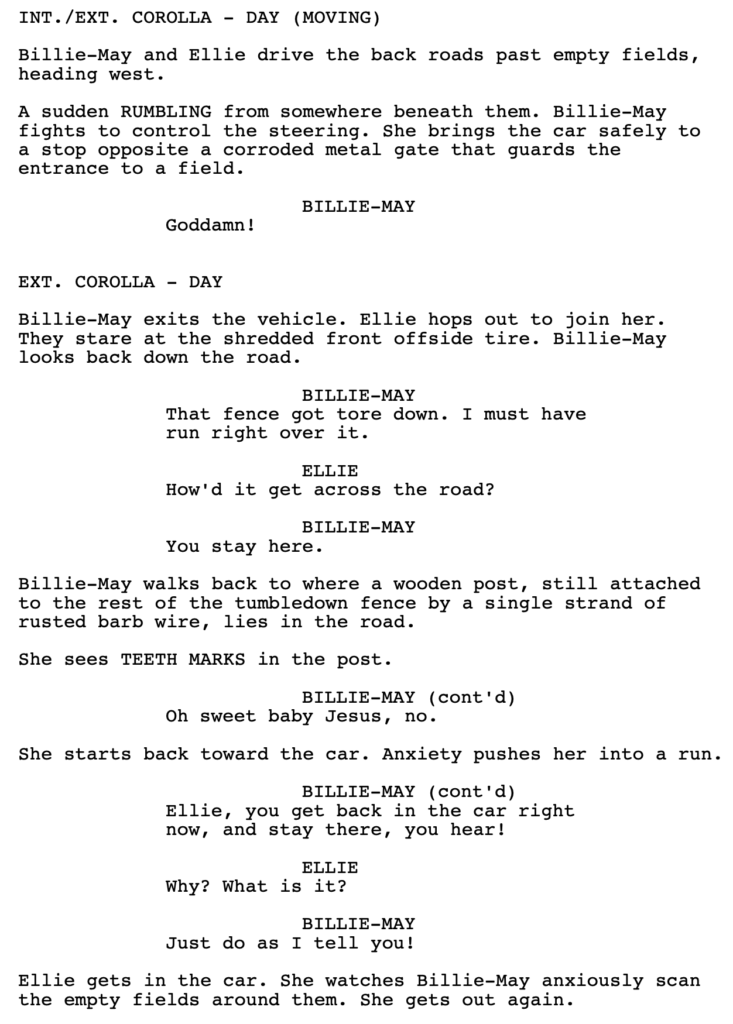
Title: ”Based on a True Story”
Genre: Comedy Feature
Logline: A struggling screenwriter recruits his writer friends to help him turn his fictional heist script into a True Story in the hopes it’ll make it more marketable.
Scene Setup: Our protagonist, Andrew, is trying to convince his writer friends to help him act out the events of his screenplay so he can claim it’s a true story, thereby making it much more marketable. He wants to use the money to save the bar he works at (and lives in).
Full Scene Link: Based on a True Story
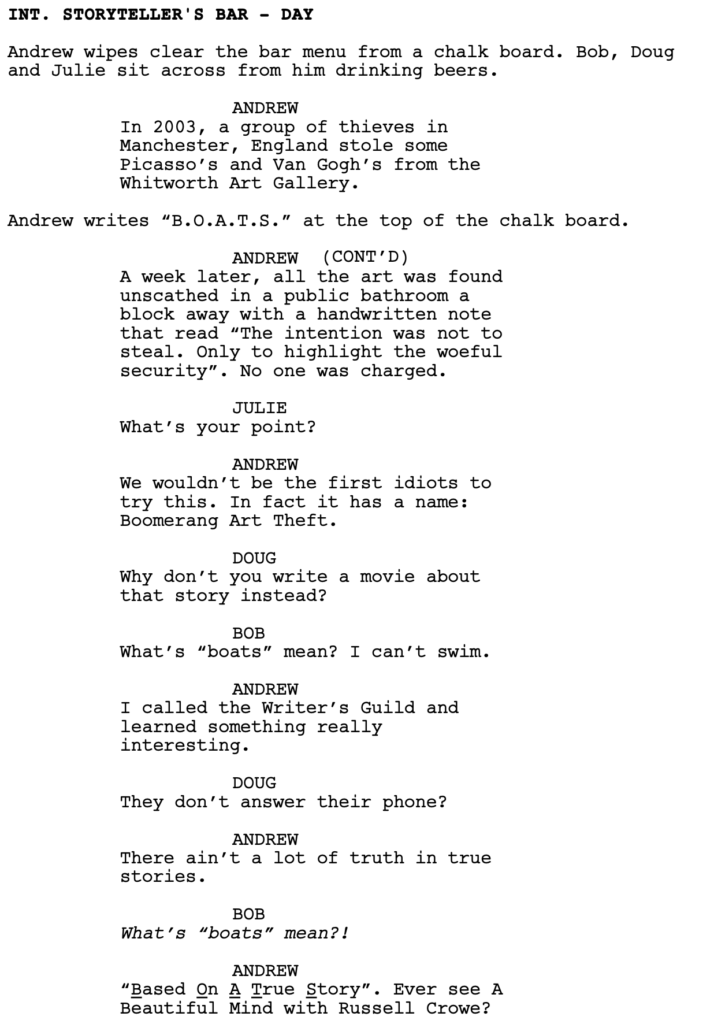
Title: American Sunshine
Genre: Drama, Crime, Period
Logline: In 1959 Palm Springs, a sleazy private eye teams up with a local Mexican teenager to find out who’s behind the murders happening in section 14, a square mile where all of the poor help live.
Scene Setup: Opening scene
Full Scene Link: American Sunshine
